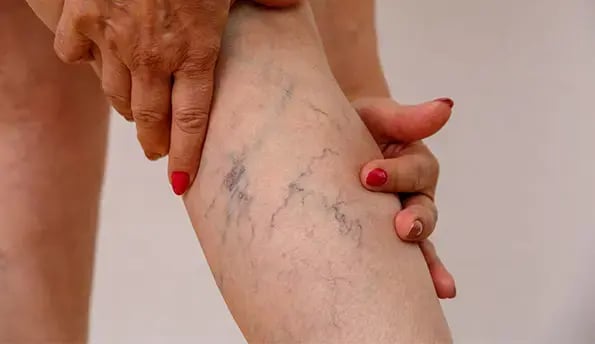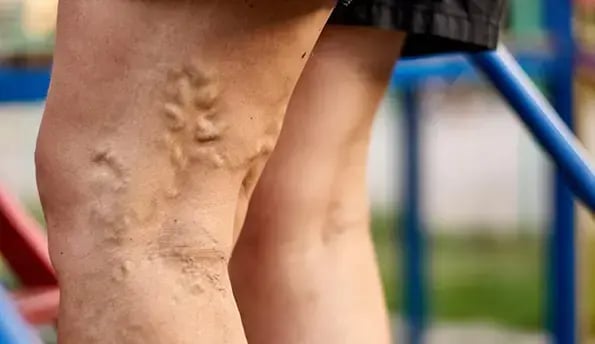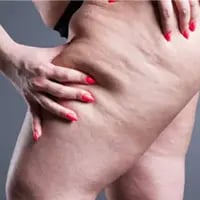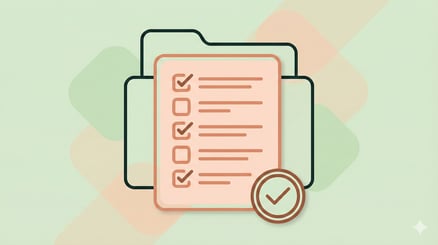What are Varicose Veins?
Exploring Varicose Veins: Causes, Symptoms, and Treatment Options
Varicose veins are defined as enlargements of the veins under the skin. Varicose veins, which are blue, enlarged, and twisted just under the skin, usually cause discomfort in terms of aesthetics in the first period but may cause pain in the later process.
The enlargement of the veins leads to the appearance of swelling in the body. However, with the increase in varicose findings, even large vessel packages and vessel cracks can be seen. The incidence of varicose veins increases with advancing age.

When to See a GP?
Varicose veins are mostly benign. However, in C2 and higher stages, serious problems may arise from circulatory disorders in the legs. At this point, patients may encounter issues such as;
- Pain
- Feeling of fullness
- Inability to stand for long periods
- Difficulty walking or inability to walk
Such situations, unfortunately, negatively affect the quality of life. Severe bleeding can occur even with small bumps, especially in elderly patients. If left untreated, a clot may form in the vein. This condition is called thrombophlebitis. In addition, failure to treat may cause ulcers and infections caused by these ulcers. Even in rare cases, ulcers can turn into cancer. Therefore, varicose veins should be taken seriously, and treatment should not be delayed.
Causes of Varicose Veins
With the failure of the venous valve, the blood is constantly withdrawn and pooled. This causes an increase in pressure and swelling in the vein. As time passes, this expansion continues to increase, and curls form.
Some of the factors that may be effective in the formation of varicose veins can be listed as follows:
- Pregnancy
- Obesity
- Standing for long periods
- Some situations arising from your profession
- Being a woman (Women experience this disorder more often than men)
- Genetic factors
- Birth control pills
- Hormone treatments
- Wearing tight clothing
- Constipation
- Age
Our mission is to create a world where every investment in modern beauty is Worth It.
Let's keep in touch
Get updates of the treatments you are interested
Treating Varicose Veins
The most traditional method in the treatment of varicose veins is the removal of the varicose vein. However, this treatment method is laborious and causes a prolongation in the healing process. Apart from this method, Vascular Sclerotherapy stands out as another treatment method. However, there is a possibility of recurrence of varicose veins in this treatment method.
In treating varicose veins with laser, which stands out as another treatment method, a catheter is inserted into the vein, and the varicose vein is burned with the help of a laser beam. In the Radiofrequency method, another varicose treatment method, catheter use is also in question. This method sends radio waves to the varicose vein through the catheter. The heat generated at this stage burns the varicose vein. It should be noted that local anesthesia is used during the treatment, as mentioned earlier methods. It is also possible for patients to be discharged immediately after these treatment methods.
As can be seen, surgical and non-surgical treatment methods can be applied in treating varicose veins. The principles of application of these methods can be explained in general under the following headings:
Varicose Veins Surgery

Laser Method
Radiofrequency Method

Sclerotherapy and Foam Therapy
Sclerotherapy is also known as needle therapy. This method delivers a drug into the vein through the needle. The drug is intended to freeze and neutralize the incompetent vein. However, this method can only be applied to superficial capillaries, not main vessels.
Foam therapy, on the other hand, is the most frequently used method among current varicose treatments. In this treatment method, the drug used in sclerotherapy is used. However, this time, the drug is contacted with air and foamed. Afterward, this foamed drug is injected into the incompetent vein.
The difference between foam treatment and needle treatment is that much less drug is used, and it provides a quicker effect in large veins. The drug given into the vein freezes the vein and makes it ineffective.
Our mission is to create a world where every investment in modern beauty is Worth It.
Let's keep in touch
Get updates of the treatments you are interested
Compression Stockings
Complications of Varicose Veins
Varicose veins manifest themselves with some symptoms in the individuals it affects. We can list these symptoms as follows:
- Blue/purple swellings on the legs
- Pain
- Swelling in the leg area
- Numbness in the legs
- Feeling of heaviness in the legs
- Itching
.webp?width=595&height=344&name=varicos%20(1).webp)
Preventing Varicose Veins
You can make some changes in your lifestyle to prevent the formation of varicose veins. We can list the situations that may help you in this regard, in general terms, as follows:
- Exercising regularly (running, brisk walking, swimming)
- Avoiding standing for long periods
- Again, avoid sitting for long periods of time
- If you are overweight, get rid of those extra pounds
- Not sitting cross-legged for a long time
- Avoiding wearing very tight clothing as much as possible
- Wearing comfortable shoes rather than high heels
- Avoiding constipation by consuming foods high in fiber
- If you must stand for a long time, rest with your legs raised for relaxation.
Exploring Varicose Veins: Causes, Symptoms, and Treatment Options
Varicose veins are defined as enlargements of the veins under the skin. Varicose veins, which are blue, enlarged, and twisted just under the skin, usually cause discomfort in terms of aesthetics in the first period but may cause pain in the later process.
The enlargement of the veins leads to the appearance of swelling in the body. However, with the increase in varicose findings, even large vessel packages and vessel cracks can be seen. The incidence of varicose veins increases with advancing age.

When to See a GP?
Varicose veins are mostly benign. However, in C2 and higher stages, serious problems may arise from circulatory disorders in the legs. At this point, patients may encounter issues such as;
- Pain
- Feeling of fullness
- Inability to stand for long periods
- Difficulty walking or inability to walk
Such situations, unfortunately, negatively affect the quality of life. Severe bleeding can occur even with small bumps, especially in elderly patients. If left untreated, a clot may form in the vein. This condition is called thrombophlebitis. In addition, failure to treat may cause ulcers and infections caused by these ulcers. Even in rare cases, ulcers can turn into cancer. Therefore, varicose veins should be taken seriously, and treatment should not be delayed.
Causes of Varicose Veins
With the failure of the venous valve, the blood is constantly withdrawn and pooled. This causes an increase in pressure and swelling in the vein. As time passes, this expansion continues to increase, and curls form.
Some of the factors that may be effective in the formation of varicose veins can be listed as follows:
- Pregnancy
- Obesity
- Standing for long periods
- Some situations arising from your profession
- Being a woman (Women experience this disorder more often than men)
- Genetic factors
- Birth control pills
- Hormone treatments
- Wearing tight clothing
- Constipation
- Age
Our mission is to create a world where every investment in modern beauty is Worth It.
Let's keep in touch
Get updates of the treatments you are interested
Treating Varicose Veins
The most traditional method in the treatment of varicose veins is the removal of the varicose vein. However, this treatment method is laborious and causes a prolongation in the healing process. Apart from this method, Vascular Sclerotherapy stands out as another treatment method. However, there is a possibility of recurrence of varicose veins in this treatment method.
In treating varicose veins with laser, which stands out as another treatment method, a catheter is inserted into the vein, and the varicose vein is burned with the help of a laser beam. In the Radiofrequency method, another varicose treatment method, catheter use is also in question. This method sends radio waves to the varicose vein through the catheter. The heat generated at this stage burns the varicose vein. It should be noted that local anesthesia is used during the treatment, as mentioned earlier methods. It is also possible for patients to be discharged immediately after these treatment methods.
As can be seen, surgical and non-surgical treatment methods can be applied in treating varicose veins. The principles of application of these methods can be explained in general under the following headings:
Varicose Veins Surgery

Laser Method
Radiofrequency Method

Pasting Method
Sclerotherapy and Foam Therapy
Sclerotherapy is also known as needle therapy. This method delivers a drug into the vein through the needle. The drug is intended to freeze and neutralize the incompetent vein. However, this method can only be applied to superficial capillaries, not main vessels.
Foam therapy, on the other hand, is the most frequently used method among current varicose treatments. In this treatment method, the drug used in sclerotherapy is used. However, this time, the drug is contacted with air and foamed. Afterward, this foamed drug is injected into the incompetent vein.
The difference between foam treatment and needle treatment is that much less drug is used, and it provides a quicker effect in large veins. The drug given into the vein freezes the vein and makes it ineffective.
Our mission is to create a world where every investment in modern beauty is Worth It.
Let's keep in touch
Get updates of the treatments you are interested
Compression Stockings
Complications of Varicose Veins
Varicose veins manifest themselves with some symptoms in the individuals it affects. We can list these symptoms as follows:
- Blue/purple swellings on the legs
- Pain
- Swelling in the leg area
- Numbness in the legs
- Feeling of heaviness in the legs
- Itching
.webp?width=595&height=344&name=varicos%20(1).webp)
Preventing Varicose Veins
You can make some changes in your lifestyle to prevent the formation of varicose veins. We can list the situations that may help you in this regard, in general terms, as follows:
- Exercising regularly (running, brisk walking, swimming)
- Avoiding standing for long periods
- Again, avoid sitting for long periods of time
- If you are overweight, get rid of those extra pounds
- Not sitting cross-legged for a long time
- Avoiding wearing very tight clothing as much as possible
- Wearing comfortable shoes rather than high heels
- Avoiding constipation by consuming foods high in fiber
- If you must stand for a long time, rest with your legs raised for relaxation.










